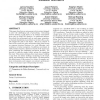41 search results - page 5 / 9 » Comparing a computer agent with a humanoid robot |
AAAI
2008
13 years 10 months ago
2008
In multi-robot settings, activity recognition allows a robot to respond intelligently to the other robots in its environment. Conditional random fields are temporal models that ar...
ICRA
2005
IEEE
14 years 1 months ago
2005
IEEE
— Imitation is a powerful mechanism for transferring knowledge from an instructor to a na¨ıve observer, one that is deeply contingent on a state of shared attention between the...
KI
2010
Springer
13 years 5 months ago
2010
Springer
Abstract. This paper presents a novel method for developing and evaluating intelligent robot behavior for joint human-robot activities. We extended a physical simulation of an auto...
ATAL
2008
Springer
13 years 9 months ago
2008
Springer
This paper describes an autonomous robot system designed to solve the challenging task of geocaching. Geocaching involves locating a goal object in an outdoor environment given on...
CEC
2003
IEEE
14 years 25 days ago
2003
IEEE
A population of virtual robots is evolved to perform the task of competitively painting the floor of a toroidal room. Two robots are present in any given room and paint using dis...

